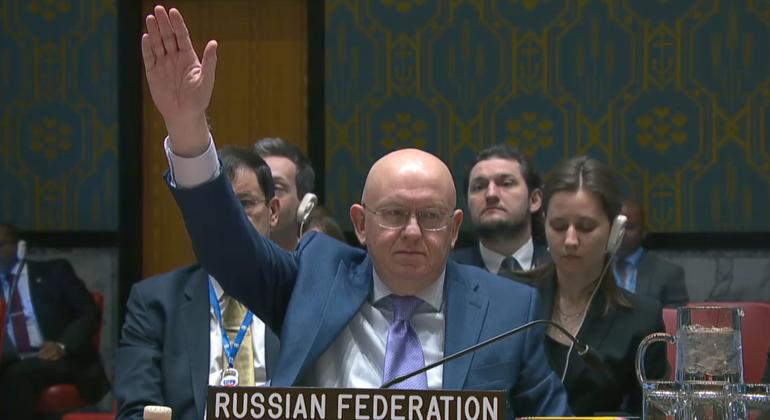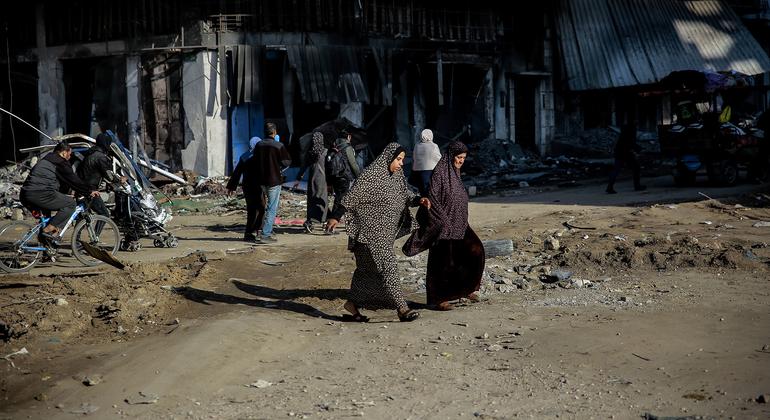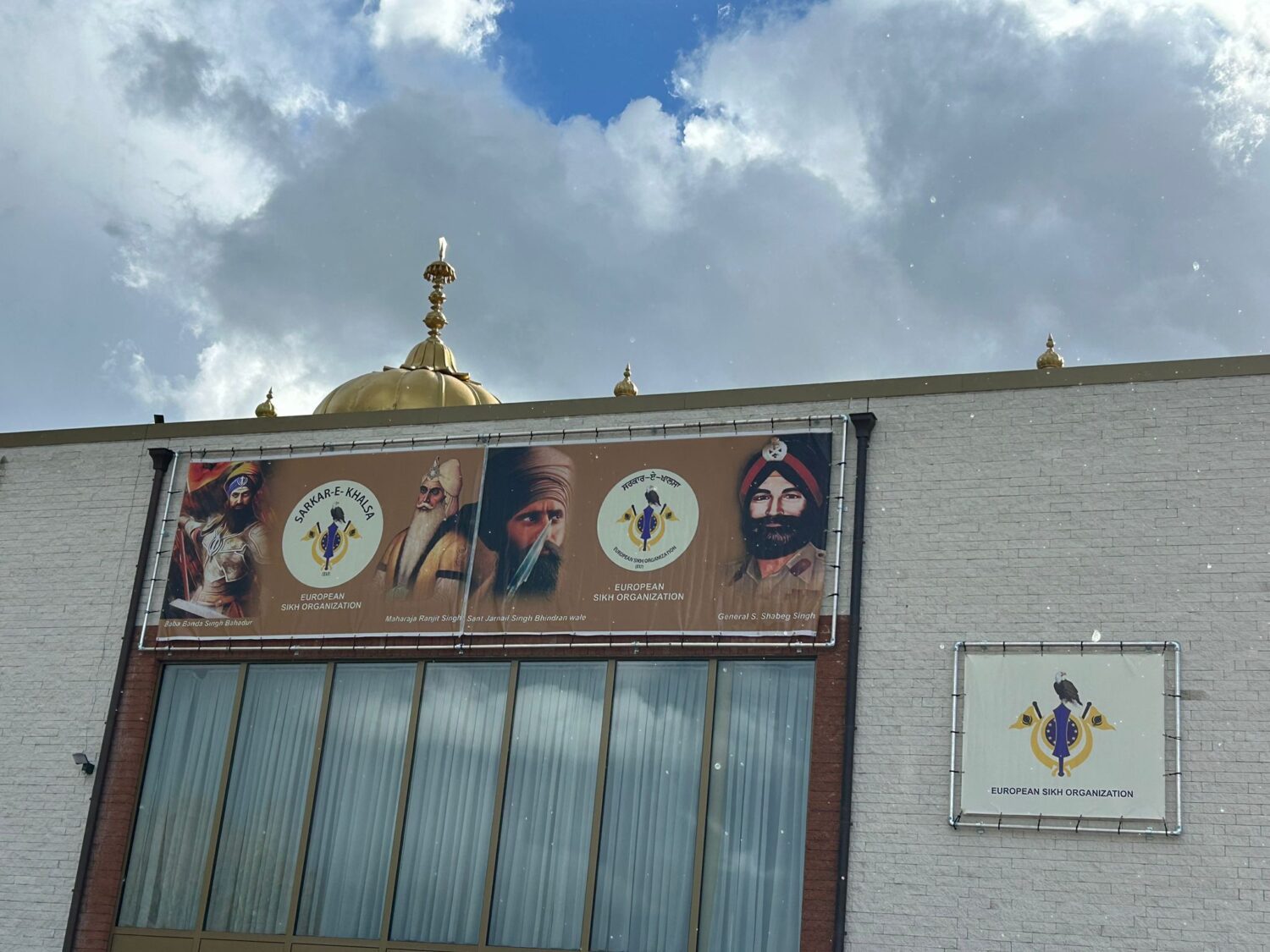The US-led draft, which took weeks to reach a vote, stated the “imperative” for “an immediate and sustained ceasefire to protect civilians on all sides”, facilitating “essential” aid delivery and supporting ongoing talks between Israel and Hamas militants to create a sustainable end to the hostilities, tied to the release of hostages.
10:36 AM – The meeting has adjourned and there is speculation that ambassadors may return to the Chamber this afternoon in New York in emergency session to debate the new draft which both Russia and China indicated they would support.
Here are the highlights of all this morning’s intense diplomatic action.
HIGHLIGHTS
- A US-proposed draft to end the war in Gaza was vetoed by permanent Council members China and Russia, in a vote of 11 favour to three against (Algeria, China, Russia) and one abstention (Guyana)
- Several ambassadors voiced their support for a new draft proposed by the “E-10” group of 10 non-permanent Council members, which calls for an immediate ceasefire
- The vetoed draft would have made imperative an immediate and sustained ceasefire in Gaza, with an “urgent need to expand the flow of humanitarian assistance” to all civilians and lifting “all barriers” to delivering aid
- Council members disagreed over elements of the draft, and some highlighted glaring exclusions despite having raised multiple concerns with the US during negotiations
- Ambassadors largely supported swift action to bring food and lifesaving aid at scale into Gaza, where a UN-backed report on Monday raised alarms about famine as Israel continues to block and slow walk shipments into the besieged enclave
- Some Council members called for pursuing the two-State solution to the ongoing conflict
- Israel’s ambassador was invited to speak, calling the draft’s failure to pass and condemn Hamas “a stain that will never be forgotten”
- For summaries of this and other UN meetings, visit our colleagues at the UN Meetings Coverage in English and French
Arab Group condemns continuing ‘genocide’ in Gaza
Representatives of the Arab Group of nations at the UN, went to the media stakeout outside the Security Council following the vote and said they backed the words of Algeria’s Ambassador in the chamber earlier.
Riyad Mansour, Permanent Observer of Palestine, said that the Group was united and condemned in the strongest terms “this genocide inflicted on the Palestinian people in the Gaza Strip”. Watch the full remarks below:
10:20 AM
Israel lets aid into Gaza, yet Council fails to condemn Hamas, says Ambassador
Ambassador Gilad Erdan, Permanent Representative of Israel to UN, addressing the Security Council meeting on the situation in the Middle East, including the Palestinian question.
Israeli Ambassador Gilad Erdan said the draft would have marked the first time any UN body condemned Hamas’s attack on his country, but its failure to be adopted is “a stain that will never be forgotten”.
Knowing that Hamas cannot win militarily, it uses Gazans as human shields to maximize civilian casualties so the Council will pressure Israel to ending its military operation and issues false statistics and numbers, he said.
“Every civilian death in Gaza is tragic, but the only one to blame is Hamas,” he said.
Likewise, the “libelous famine” in Gaza is just “Hamas propaganda”, he claimed, emphasizing that according to his Government, 341,000 tonnes of humanitarian aid in hundreds of trucks have entered the enclave.
The only way to achieve a ceasefire is to demolish all Hamas battalions, and “the road to a ceasefire passes through Rafah,” he said.
The war may be in Gaza, but it extends further that a battle against Hamas, and Iran remains determined to wipe Israel off the map, he added.
10:00 AM
Disaster cannot end without an immediate ceasefire: Guyana
Ambassador Carolyn Rodrigues-Birkett, Guyana’s Permanent Representative to the UN, addressing the Security Council meeting on the situation in the Middle East, including the Palestinian question.
Guyana abstained because the resolution did not call for an immediate ceasefire, said their Ambassador Carolyn Rodrigues-Birkett.
Given the appalling toll of death and injuries and destruction of Gaza “this man-made disaster cannot be halted without an immediate ceasefire, and it’s this Council’s responsibility to unequivocally demand one, even as it acknowledges the efforts of Qatar, Egypt and the United States.”
She said a ceasefire should not be linked to the taking of hostages. “The Palestinians should not themselves be held hostage for the crimes of others.”
09:49 AM
Council has ‘dragged its feet’ over clear and immediate ceasefire: China
China’s Ambassador Zhang Jun said that the most urgent action the Council should take is calling for an immediate and unconditional ceasefire, in line with the wishes of the UN General Assembly and the UN Secretary-General.
Ambassador Zhang Jun, Permanent Representative of China, addressing the Security Council meeting on the situation in the Middle East, including the Palestinian question.
He said the Council had dragged its feet and wasted too much time in this regard.
With a view to safeguarding the UN Charter and the “dignity” of the Council, together with the view of Arab States, China therefore voted against the US draft.
He pointed to the new draft resolution from the 10 elected Council members now circulating: “This draft is clear on the issue of a ceasefire and is in line with the correct direction of the Council action and is of great relevance. China supports this draft.”
He said criticism by the UK and US of China’s veto was hypocritical, and if they were serious about a ceasefire, they should support the new draft.
09:45 AM
France will propose new draft initiative
French Ambassador Nicholas de Rivière said the Security Council must continue to act at the catastrophic situation in Gaza worsens daily. Having voted for the draft, he called for the comprehensive respect of international law and for crossing points into Gaza to be opened for aid shipments.
France remains opposed to an Israeli incursion in Rafah and emphasized the urgent need to delivery ample much-needed aid into the enclave. Underlining the importance of realizing a two-State solution to the conflict, he said France will propose an initiative to the Council in this regard.
09:40 AM
US resolution would have given green light to ‘continuing bloodshed’: Algeria
Algeria’s Ambassador Amar Bendjama said that had the Council passed its resolution of late February, thousands of innocent lives could have been saved.
Algeria’s Ambassador Amar Benjama addressing the Security Council meeting on the situation in the Middle East, including the Palestinian question.
He said since the US circulated its draft over a month ago, Algeria had proposed reasonable edits to achieve a “more balanced and acceptable text”. He acknowledged that some of their proposals had been included but “core concerns remained unaddressed.”
Algeria has emphasized the urgency of an immediate ceasefire to prevent further loss of life but regrettably the draft fell short and his country had therefore voted against it.
The immense suffering endured by the Palestinian people over five months, has resulted in the tragic loss of life of more than 32,000 people in Gaza. More than 74,000 have been injured, with 12,000 suffering permanent disabilities.
These figures represent lives, dreams and “hopes that have been destroyed”, he said, stressing that the US text made no mention of Israel’s responsibility for their deaths.
The Arab and Islamic world needs acknowledgement that Israel will be held accountable, he said.
Emphasizing “measures” to reduce civilian harm and talk of “operations” implies a license for continuing bloodshed for Israel. The operation in Rafah would have devastating consequences if it goes ahead, he added.
9:30 AM
UK will ‘do everything we can’ to get aid into Gaza
United Kingdom Ambassador Barbara Woodward said her delegation voted “yes”, as Palestinians are facing a devastating crisis that requires immediate aid. As such, she expressed disappointed in China and Russia for vetoing the draft, especially since the draft would have been the first time the Council spoke out against Hamas.
Meanwhile, the UK will “do everything we can” to get desperately needed aid into Gaza by land, sea and air, she said.
09:26 AM
Alternative resolution fails to support diplomatic talks: US
Ambassador Linda Thomas-Greenfield addressing the Security Council meeting on the situation in the Middle East, including the Palestinian question.
Russia has put politics over progress in vetoing the resolution, throwing stones when it lives in a glass house, said the US ambassador.
She said Russia and China were doing nothing meaningful to advance peace.
She said the new text fails to support sensitive diplomacy in the region and could give Hamas an excuse to walk away from the deal that is on the table. She said the US would continue to work for peace alongside Qatar and Egypt in the ongoing talks.
09:22 AM
Russia and China veto US resolution
The votes are in, and there were three against, including Russia and China, which means the US draft has been vetoed. There were 11 votes in favour.
09:13 AM
Before the vote, Russian Ambassador Vassily Nebenzia said the US had promised an agreement to end the fighting time and time again.
Now, the US has finally recognized the need for a ceasefire, when more than 30,000 Gazans have already died.
He said the US was trying to “sell a product” to the Council by using the word imperative in its resolution.
“This is not enough” and the Council must “demand a ceasefire”, he declared.
He said there was no call for a ceasefire in the text, accusing US leadership of “deliberately misleading the international community.” The draft is just playing to US voters, he said, “to throw them a bone” with a false ceasefire call.
“If you pass this resolution,” he told ambassadors, “you will cover yourselves in disgrace.”
He said that an alternative draft resolution, which was a “balanced and apolitical document”, was being circulated by some other members of the Council.
09:08 AM
Speaking before the vote, US Ambassador Linda Thomas-Greenfield said her delegations wants to see an immediate and sustained ceasefire, but “we have to do the hard work of diplomacy” to make that aim a reality, and it has to be made “real on the ground”.
This is why the negotiations are going on in Qatar which will lead to a sustainable ceasefire, she said, adding that “we are close, but we are not there yet unfortunately.”
She said the draft resolution would help put pressure on Hamas to agree to a deal on ending the fighting and releasing hostages.
She argued that the resolution would at long last condemn Hamas, but also alleviate the terrible suffering and violence wracking Gaza. It also highlights that an invasion of Rafah would be a mistake.
09:06 AM
Japan’s Permanent Representative is inviting the representatives of Israel and Palestine to join the meeting.
09:00 AM
Japan has the presidency this month, and their Ambassador Yamazaki Kazuyuki is due to gavel the meeting open very soon.
08:50 AM
After weeks of behind the scenes negotiations among Security Council members in New York, the US draft marks a shift in position from the last time members met on 20 February when the US used its veto to quash an Algerian resolution which demanded an immediate ceasefire.
The US resolution, crucially, is not calling for an immediate and sustained ceasefire, rather stating the imperative for one.
Back then, 13 countries were in favour of the resolution, with the UK abstaining. The US based it opposition on the need to not interfere with “sensitive ongoing negotiations” and introduced a separate resolution condemning Hamas which would work towards a temporary ceasefire, based on the release of hostages.
What’s the US resolution calling for?
- Makes imperative an immediate and sustained ceasefire with an “urgent need to expand the flow of humanitarian assistance” to all civilians and lifting “all barriers” to delivering aid at scale to Gazans
- Israel and all armed groups must comply with their obligations under international law, providing protection for humanitarian workers and medical personnel
- Condemns all acts of terrorism including the Hamas-led attacks of 7 October, the taking and killing of hostages, murder of civilians, sexual violence and condemns the use of civilian buildings for military purposes
- Rejects any forced displacement of civilians in Gaza
- Demands that Hamas and other armed groups immediately grant humanitarian access to all remaining hostages
- Underscores the Council’s full support for the UN Senior Humanitarian and Reconstruction Coordinator Sigrid Kaag, the Special Coordinator for the Middle East Peace Process and UN Resident and Humanitarian Coordinator, so they can establish the new UN aid mechanism under previous resolution 2720
- Stressed the importance of the Senior Coordinator leading efforts for the recovery and reconstruction of Gaza
- Demands all parties respect humanitarian notification and deconfliction mechanisms in place to prevent civilian deaths
- Rejects any action by Israel that could “reduce the territory of Gaza” and condemns calls from some Israeli ministers for the resettlement of Gaza or demographic changes
- Reaffirms condemnation of the ongoing attacks by Houthi rebels in Yemen on shipping in the Red Sea
- Reiterates the Security Council’s “unwavering commitment to the vision of the two-State solution”
Here are the HIGHLIGHTS from the last time the Council held a vote on Gaza on 20 February:
- US uses veto power to quash Algeria’s draft resolution demanding an immediate ceasefire in Gaza and presents rival text that would condemn Hamas but also support a temporary ceasefire
- The US is expected to circulate its own draft later on Tuesday but news reports suggest negotiations will be far from easy, with both Russia and China voicing strong opposition to the third use of a veto by the US on ceasefire resolutions
- Council members lament continued suffering in Gaza and lambast possible Israeli military operation into Rafah
- Algeria’s ambassador says it will continue to “knock at the Council’s door” to maximize pressure on Israel and Hamas for a ceasefire which will end the bloodshed
- “This veto does not absolve Israel of its obligations,” says the ambassador for the observer State of Palestine
- A ceasefire would be “a death sentence”, for Israelis and ordinary Gazans alike, says Israel’s ambassador
- Qatar’s ambassador, speaking for the Gulf Cooperation Council, says her delegation will continue its facilitating efforts to free all hostages, protect civilians and secure a ceasefire














